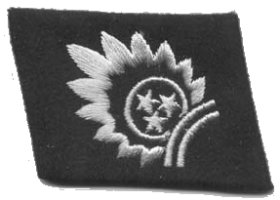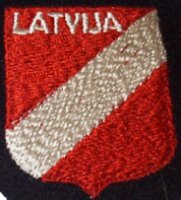Published: 24 December 2010Last Updated: 15 June 2013

The 15. Waffen-Grenadier-Division der SS (lettische Nr. 1) was formed 1943 when the newly formed Lettische SS-Freiwilligen Legion was upgraded to a division. It contained manpower from numerous Latvian units that had previously supported the Germans, including units involved in the Holocaust such as the Arājs Kommando, a unit of the Lettische Hilfspolizei controlled by the SD responsible for the murder of 20.000-30.000 Jews.
It was sent to the front November 1943 where it fought the Red Army’s winter offensive.
It was sent to West Prussia to recover from the losses suffered the Soviet offensive in the autumn of 1944. It returned to the front in January 1945 and continued fighting the Red Army until the end of the war when it managed to surrender to the western Allies.
SS-Oberführer Adolf Ax wrote about the Latvian volunteers in a report dated January 1945:
They are first and foremost Latvians! They want a sustainable Latvian nation state. Forced to choose between Germany and Russia, they have chosen Germany, because they seek co-operation with western civilization. The rule of the Germans seems to them to be the lesser two evils. The hatred of Russia is deeply rooted and was further deepened by the Russian invasion of Latvia in 1940 and the following occupation until 1941. They consider the fight against Russia to be their national duty. (2)
Known war crimes
At Podgaje (Flederborn?) in Pomerania 32 Polish prisoners from 3. Infantry Regiment of the 1st Division Polish First Army were killed on 2 February 1945 by soldiers from 15. Waffen-Grenadier-Division der SS and SS-Freiwilligen-Panzergrenadier-Regiment 48 General Seyffard of SS-Freiwilligen-Panzergrenadier-Brigade Nederland. (1)
Lineage
Lettische SS-Freiwilligen-Division (Feb 1943 – Oct 1943)
15. Lettische SS-Freiwilligen-Division (Oct 1943 – June 1944)
15. Waffen-Grenadier-Division der SS (lettische Nr. 1) (June 1944 – May 1945)
Commanders
SS-Brigadeführer Peter Hansen (25 Feb 1943 – ? May 1943)
SS-Gruppenführer Carl Graf von Pückler-Burghauss (? May 1943 – 17 Feb 1944)
SS-Brigadeführer Nikolas Heilmann (17 Feb 1944 – 21 July 1944)
SS-Brigadeführer Herbert von Obwurzer (21 July 1944 – 26 Jan 1945)
SS-Oberführer Arthur Ax (26 Jan 1945 – 15 Feb 1945)
SS-Oberführer Karl Burk (15 Feb 1945 – ? 1945)
Chief of Staff
SS-Sturmbannführer Knebel (? 1943 – ? 1944)
SS-Haupsturmführer Hahn (? 1944 – ? 1944)
Major Erich Wulff (1 Aug 1944 – 3 Feb 1945)
SS-Sturmbannführer Adolf Kopp (1 Mar 1945 – ? May 1945)
Quartermaster
SS-Hauptsturmführer Fritscher (? 1943 – ? 1944)
SS-Hauptsturmführer Egbert Hochhauser (1 Aug 1944 – ?)
SS-Hauptsturmführer Edler von Zenetti (1 Mar 1945 – ?)
Area of operations
Eastern front, northern sector (Aug 1943 – Jan 1945)
Pomerania & Berlin (Jan 1945 – May 1945)
Manpower strength
Dec 1943 20.291
June 1944 18.413
Dec 1944 16.870
Holders of high awards
Holders of the German Cross in Gold (2)
– Janums, Vilis, 00.03.1945, Waffen-Standartenführer, Kdr. Waffen-Gren.Rgt. d. SS 33 (lett. Nr. 4)
– Pomrehn, Hans, 09.03.1945, SS-Hauptsturmführer, 15. Waffen-Gren.Div. d. SS (lett. Nr. 1)
Holders of the Honor Roll Clasp of the Waffen-SS (1)
– Hazners, Vilis, 15.08.1944, Waffen-Sturmbannführer, SS-Gren.Rgt. 32 (lett. Nr. 3)
Holders of the Knight’s Cross (4, including two unofficial/unconfirmed)
– Aperats, Karlis 21.09.1944 Waffen-Obersturmbannführer Kdr Waffen-Gren.Rgt der SS 32
– Ax, Adolf 09.05.1945 SS-Oberführer Führer 15. Waffen-Gren.Div der SS
[original troop proposal without treatment existing ; Karteikarte with in-date “28.04.1945” ; HPA-VV #5092 prepared ; no further confirmation / proof to find in the files ; case treated by OdR Ordenskommission in 1981 and decided : “RK ja, 9.5.1945”]
– Heilmann, Nikolaus 23.08.1944 SS-Oberführer Kdr 15. Waffen-Gren.Div der SS (lett. Nr.1)
– Wulff, Erich 09.05.1945 Major i.G (kommandiert zur W-SS) Ia 15. Waffen-Gren.Div der SS
[according to the files in Bundesarchiv a proposal was treated and an official proposal was prepared, but was unfinished at war’s end ; note on Karteikarte : “unerledigt” ; statement of Bundesarchiv in 2004 that a proof for this award is not to find]
Order of battle
Waffen-Grenadier Regiment der SS 32
Waffen-Grenadier Regiment der SS 33
Waffen-Grenadier Regiment der SS 34
Waffen-Artillerie Regiment der SS 15
Waffen-Füsilier Bataillon der SS 15
Waffen-Flak Abteilung der SS 15
Waffen-Nachrichtung Abteilung der SS 15
Waffen-Pionier Bataillon der SS 15
Waffen-Panzerjäger Abteilung der SS 15
SS-Sanitäts Abteilung 15
SS-Nachschub Truppen 15
SS-Feldpostamt 15
SS-Veterinär-Kompanie 15
SS-Wirtschafts-Bataillon 15
SS-Bau-Regiment 1 der 15. SS-Division
SS-Bau-Regiment 2 der 15. SS-Division
SS-Feldersatz-Bataillon 15
SS-Waffen-Feldgendarmerie-Trupp 15
SS-Kriegsberichter-Trupp
Notable members
Viktors Arājs (commander of the infamous Arājs Kommando, a Latvian unit of the Lettische Hilfspolizei responsible for the murder of 20.000-30.000 Jews, served briefly as battalion commander in 1945)
Officers serving in the Einsatzgruppen and Concentration Camps
Concentration Camps 5
(includes officers serving in the Einsatzgruppen or Concentration Camps either prior to or after service in this unit)
Insignia
A collar insignia with the Latvian fire cross (swastika) was authorized on 11 March 1943. The Latvian Fire Cross (ugunskrusts in Latvian or Thunder Cross, pērkonkrusts) dates back to the Bronze age and was also used as a aircraft marking in the Latvian Air Force 1918-1934.
It was also used as a symbol by the Latvian fascist party Ugunskrusts founded in 1932 by Gustavs Celmiņš. It was banned shortly afterwards but was reformed as Pērkonkrusts until it was again banned in 1934.
Obersturmbannführer Nikolajs Galdins with the special Fire Cross collar patch
(Courtesy of Dave)
A new collar insignia was authorized late 1944, this one showing the sun and stars.
The SS runes were also used on the collar tabs despite the soldiers not being Germans.
(Courtesy of The Ruptured Duck)
Latvian national sleeve shield
(Courtesy of The Ruptured Duck)
Footnotes
1. “Towarzysze frontowych drog” by Stanislaw Poplawski, “Podgaje” by Andrzej Czerkawski.
2. “An deutscher Seite: Internationale Freiwillige von Wehrmacht und Waffen-SS” by Hans Werner Neulen, page 294.
Sources used
Christopher Ailsby – Hitler’s Renegades: Foreign nationals in the service of the Third Reich
John R. Angolia – Cloth insignia of the SS
Georges M. Croisier – Waffen-SS (PDF)
Andrzej Czerkawski – Podgaje (Warszawa 1968)
Zvi Y. Gitelman (ed.) – Bitter Legacy: Confronting the Holocaust in the USSR
Terry Goldsworthy – Valhalla’s Warriors: A history of the Waffen-SS on the Eastern Front 1941-1945
Dr. K-G Klietmann – Die Waffen-SS: eine Dokumentation
David Littlejohn – Foreign Legions of the Third Reich, vol 4
Kurt Mehner – Die Waffen-SS und Polizei 1939-1945
Hans Werner Neulen – An deutscher Seite: Internationale Freiwillige von Wehrmacht und Waffen-SS
Stanislaw Poplawski – Towarzysze frontowych drog (Warszawa 1983)
Bernhard Press – The Murder of the Jews in Latvia 1941-1945
Marc J. Rikmenspoel – Waffen-SS Encyclopedia
George H. Stein – The Waffen-SS: Hitler’s Elite Guard at War 1939-1945
Frank Thayer – SS Foreign volunteer collar insignia and their reporductions (in The Military Advisor, Vol 4 No 2)
Gordon Williamson – The Waffen-SS: 11. to 23. Divisions
Mark C. Yerger – Waffen-SS Commanders: The Army, corps and divisional leaders of a legend (2 vol)
Reference material on this unit
Mintauts Blosfelds – Stormtrooper on the Eastern Fronts: Fighting with Hitler’s Latvian SS
Rolf Michaelis – Latvians in the Ordnungspolizei and Waffen-SS
Arthur Silgailis – Latvian Legion
Hans Stöber – Die Lettischen Divisionen Im VI. SS-Armeekorps


